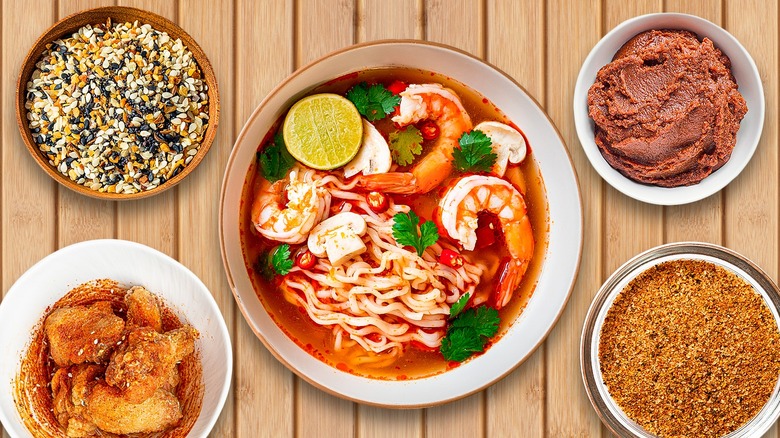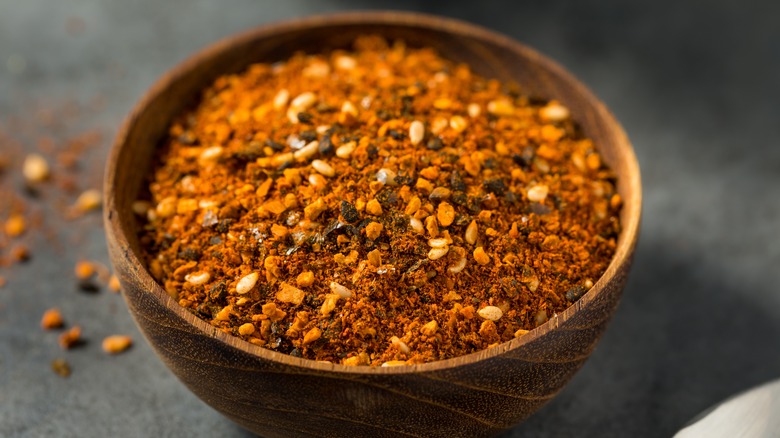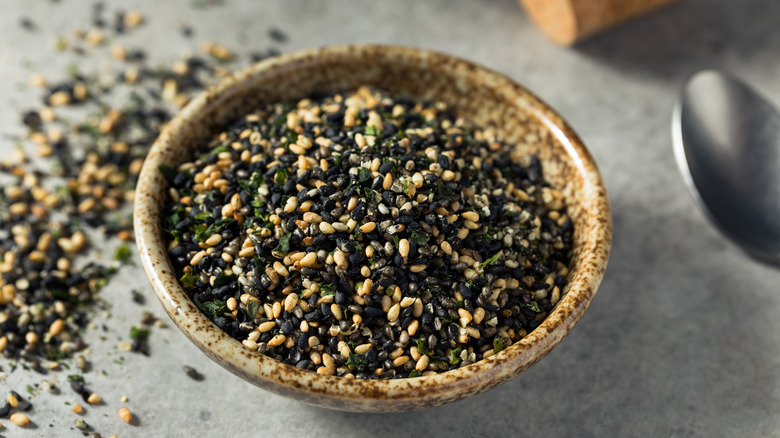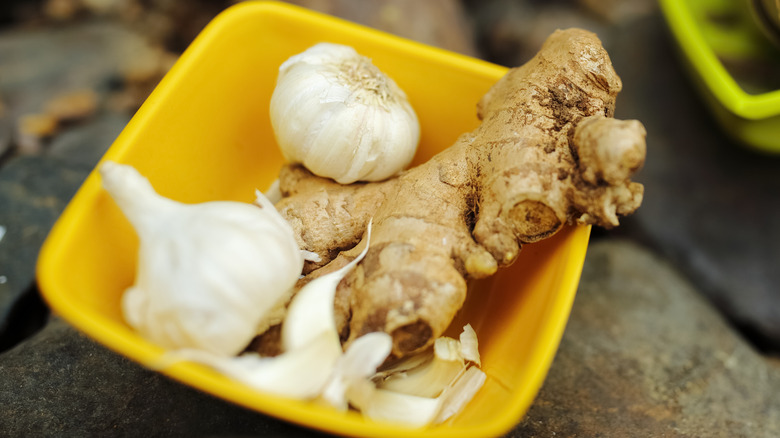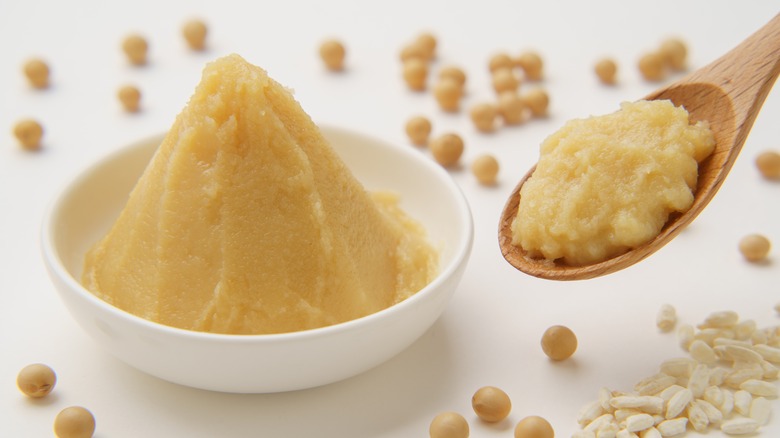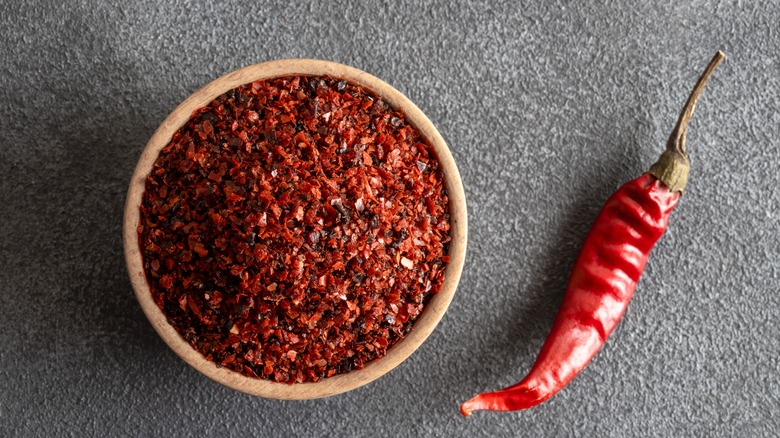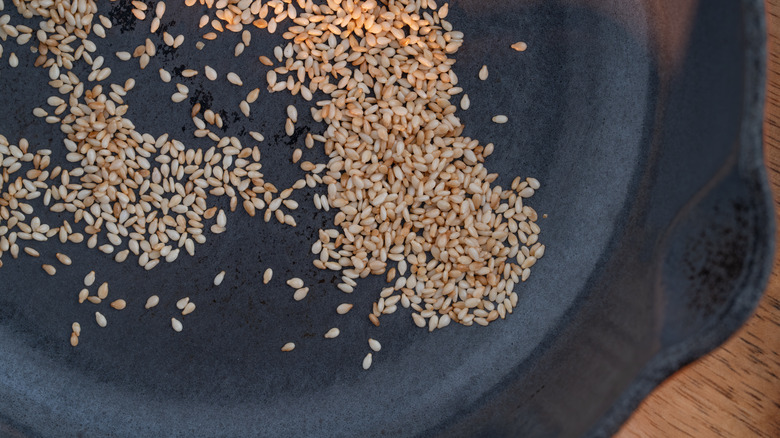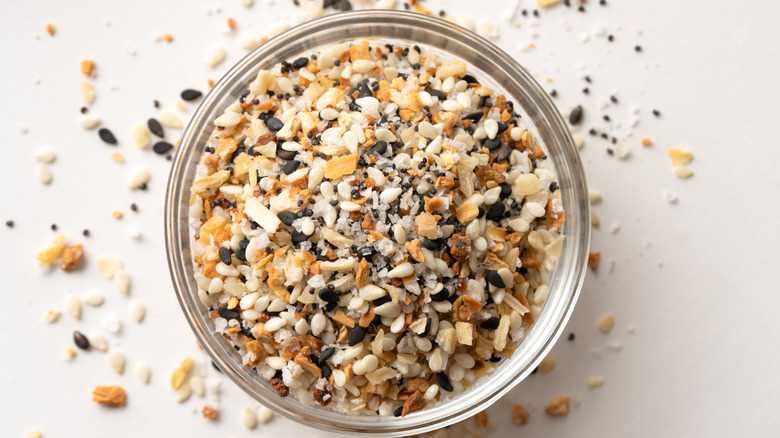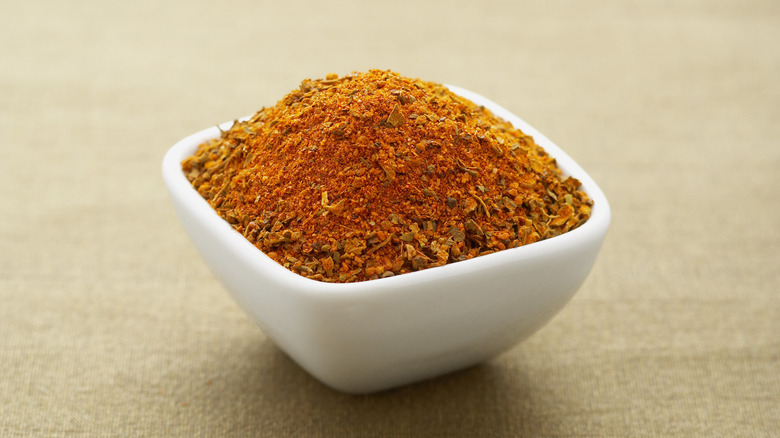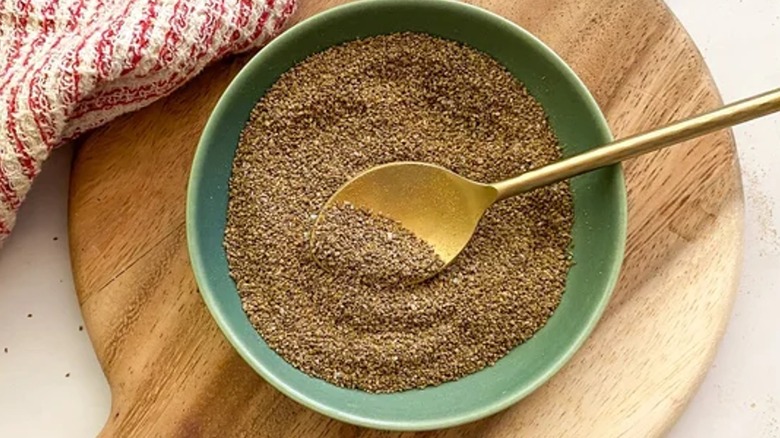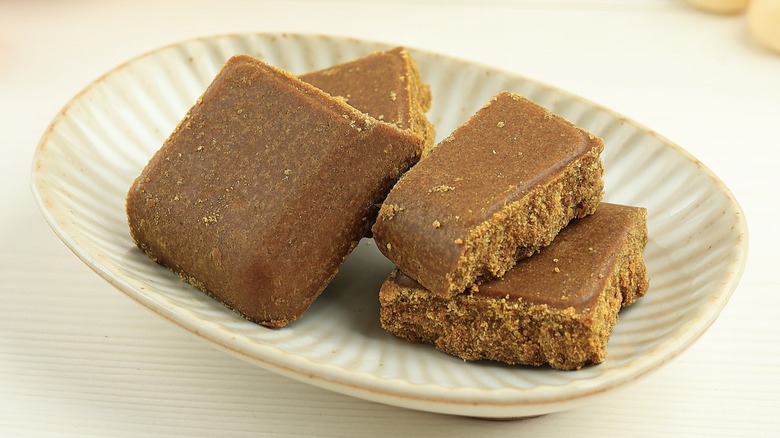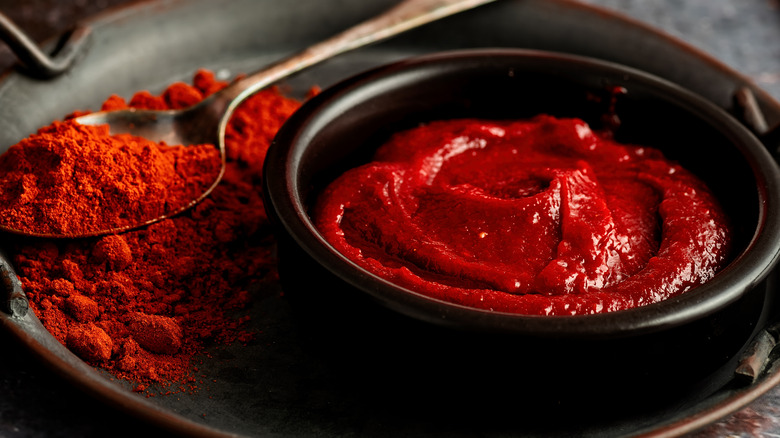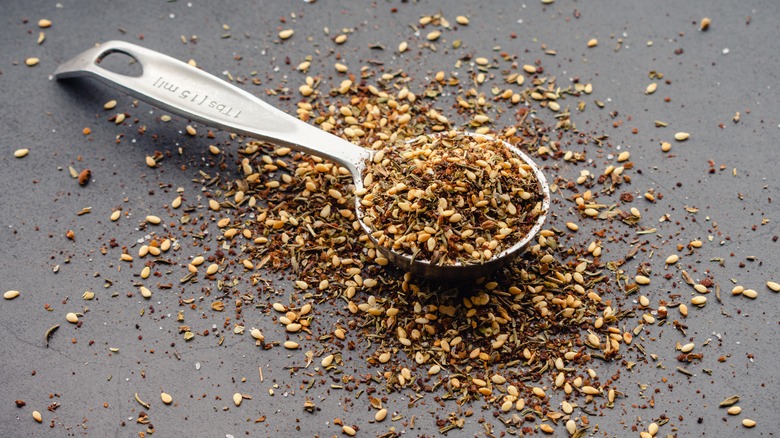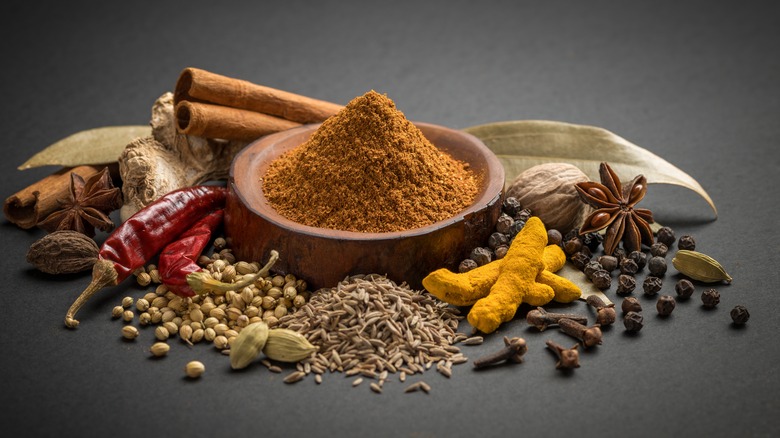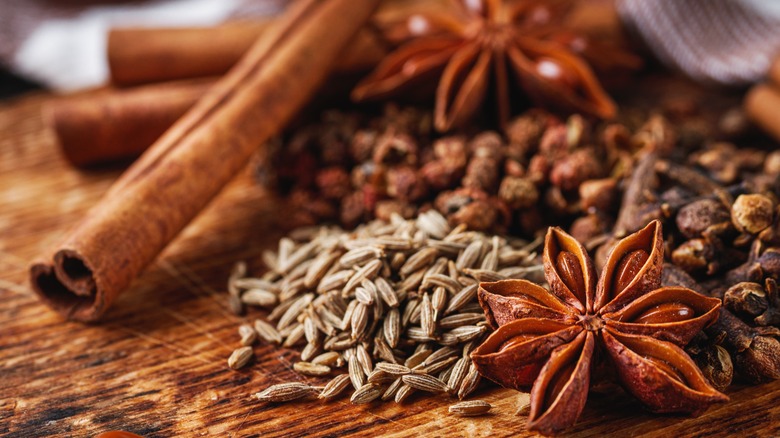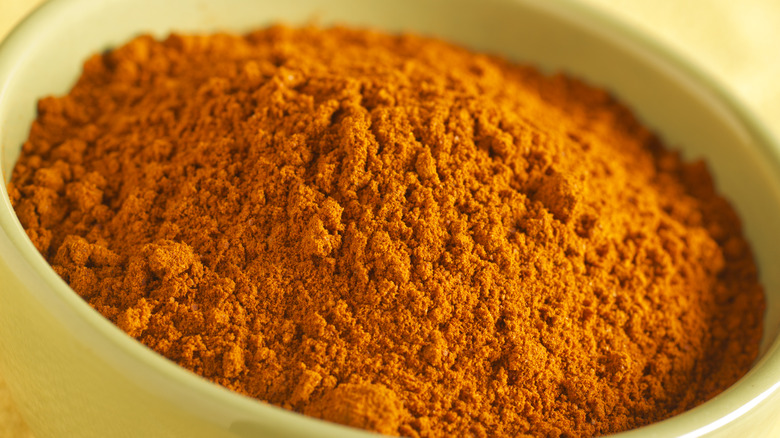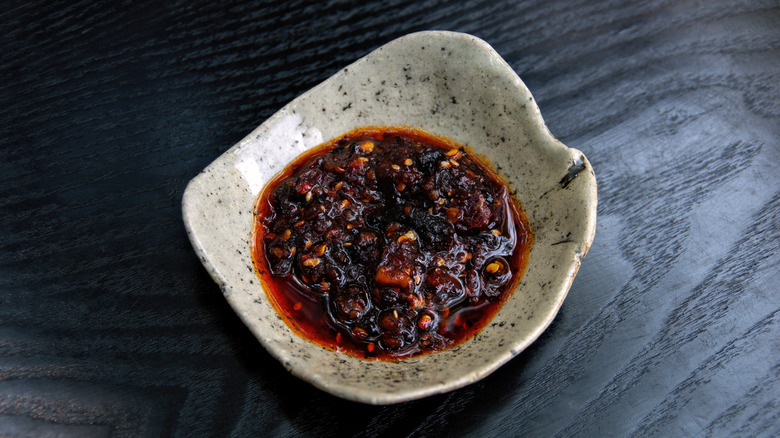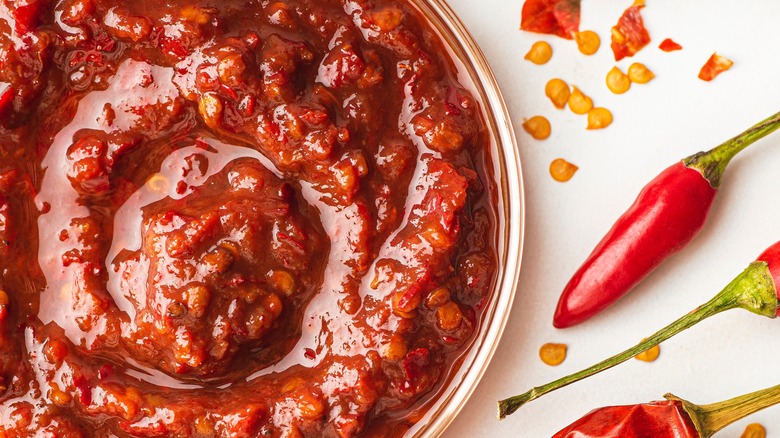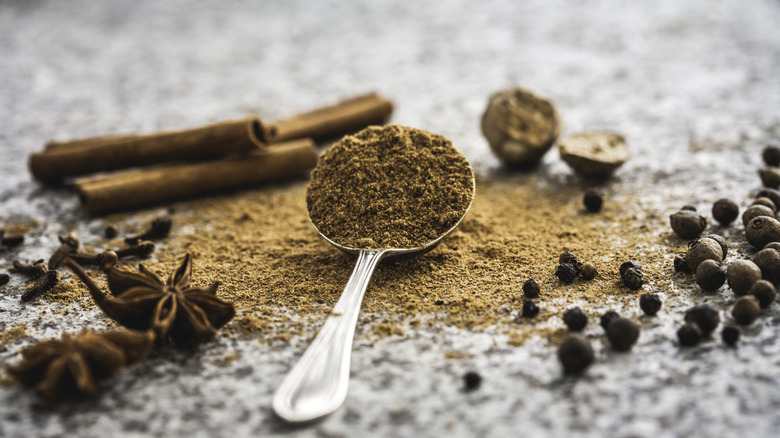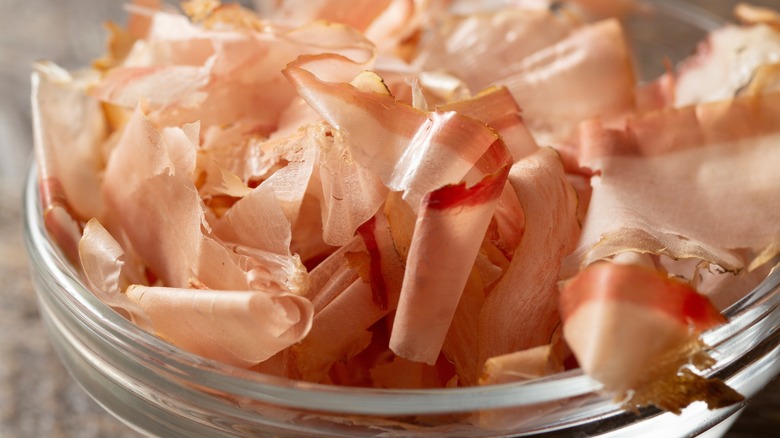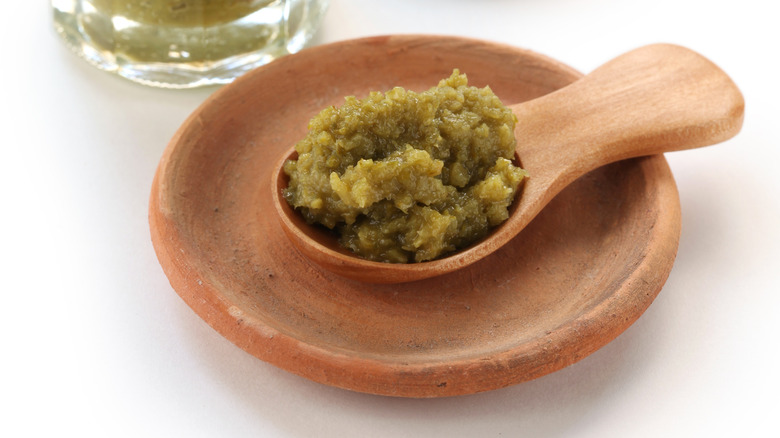20 Seasonings That Will Give Ramen A Flavor Boost
We may receive a commission on purchases made from links.
Whether you like your ramen simple or extravagant, there are dozens of seasonings that can provide a quick flavor infusion to take it to the next level. If you're looking for something to change up ordinary ramen into something crave-worthy, the answer may already be sitting in your spice cabinet or refrigerator. We've found spices that add new flavor notes while deepening umami, acidic, spicy heat, and other flavor profiles.
Since the type of ramen we enjoy today first became popular in Japan, we've included some Japanese seasoning add-ins. However, with instant ramen noodles being cheap and easy to make, it's a soup that has gained fans around the world. So, we've looked to seasonings from around the world to help inspire your next hot and steaming bowl. These 20 seasonings we mention can certainly be used on their own to add extra flavor, but many of them are even better when you use them in concert with contrasting aromatics and seasonings. These 20 are just a start. Mix and match and look in your cabinet to see what else might add the extra punch of flavor you're looking for.
Shichimi togarashi
When making ramen, some of the best seasonings that can provide a flavor boost are Japanese ones. One that provides lots of extra flavor is shichimi togarashi because it adds spiciness, umami, and tart citrus flavors to your ramen. While the name for this spice translates to "seven chili peppers," it's really a combination of seven spices rather than seven types of chili pepper. The ingredients in this Japanese seasoning mix include a ground combination of dried seaweed, citrus (ranging from orange peels to yuzu), hot chili pepper (sometimes cayenne), sesame seeds, ginger, poppy seeds, and pepper (black or white). If you can't find it locally, you can buy brands like House Shichimi Togarashi online. It's especially great in ramen when combined with ingredients like crispy garlic and sesame oil.
Furikake
Another Japanese seasoning mix, furikake, can be a no-brainer when it comes to seasonings that go well with ramen. After all, its name means "to sprinkle over." So, you're just following instructions if you have it in your cupboard near your ramen. Granted, there are a few variations on what you'll find in furikake, depending on the region it's from. However, they tend to be a variation on the theme of dried seaweed, dried fish flakes, miso powder, sugar, and sesame seeds. The fish flakes and dried seaweed both provide extra umami flavors to your ramen through their natural glutamate profiles. It also tends to offer up saltiness from either salt, an infusion of soy sauce, or both. So, it's especially good to use when your ramen needs more umami flavor depth or more saltiness. Plus, the dried fish flakes can lend extra meatiness in both texture and flavor.
Ginger and garlic
While ginger and garlic tend to be an aromatic flavor base you're most likely to find in Indian cooking, it can also work for adding flavor to ramen even though it's not common in Japan. It's especially good in combination with other aromatics like green onions that are more common in traditional Japanese ramen recipes. You can either add in fresh ginger and garlic when you're laying down the aromatic base for your ramen — for example, when you're sautéing shallots and green onions to start off the base for your broth. However, you can also opt to add dried ginger and garlic as well. Either way, it provides an added layer of flavor and spiciness. The more you add (especially ginger), the spicier your ramen will be.
Miso
With miso being common in Japanese cooking and as an ingredient in Japanese soup bases, it makes an excellent add-in or base for ramen when you're looking to give it an umami punch. Miso is fermented soybean paste that you can often find in a variety of flavors. While plain miso like Fusion Organic White Miso makes a good base, you can also opt for something a little fancier, like Hikari Dashi Miso, which contains bonito and kelp stock. However, you'll likely want to avoid hatcho miso since its strong flavor isn't as universally appealing. Saikyo miso is another you may want to avoid because of its sweetness level. Miso is a good start, but you'll likely also want to add extra aromatics to amp up the flavor, such as garlic, ginger, shallots, and green onions.
Red pepper flakes, cayenne, or gochugaru
If you're looking for seasonings to add more heat to your ramen, seasonings made from peppers are especially nice for this job. Red pepper flakes and cayenne provide heat that hits in different ways on your tongue. So use one or both based on your preferences. We especially enjoy using gochugaru in our ramen, which is a mild Korean spice made from chili pepper flakes that provides flavor, heat, and color to the soup (a favorite is Wang Sun-Dried Coarse Gochugaru). A pinch of pepper flakes or cayenne will do for mild heat, but you could also build your flavor profile around your heat source, too. If you're a serious fan of heat in your ramen, don't just stop at pepper flakes or cayenne. Keep building the heat flavor profile with other hot and spicy ingredients like sriracha, chili garlic sauce, green onions, garlic, and ginger.
Toasted sesame seeds
Whether you're eating packaged ramen without any frills or fancy ramen full of loads of luscious ingredients, toasted sesame seeds can be the last-minute seasoning that takes your ramen to the next level. There's a pronounced flavor difference between regular sesame seeds and toasted ones. While regular ones are slightly nutty, the nuttiness level goes from a one to a 10 when you toast them. Thus, the flavor becomes closer to that of sesame oil. You can buy pre-toasted sesame seeds like McCormick Gourmet Toasted Sesame Seeds at a fairly reasonable price. But it's also easy enough to toast regular sesame seeds yourself on the stovetop in a little oil. If you want the toasted sesame flavor to be even more pronounced, go ahead and add sesame oil or toasted sesame oil to your ramen, too.
Everything bagel seasoning
We've all grabbed an off-brand of ramen or made ramen broth from scratch, only to be met with disappointment. But it turns out that everything bagel seasoning can be a fix-all when it comes to lackluster broths. Not only does it provide a punch of flavor with dried onions and garlic, but it adds nuttiness and texture with sesame seeds and poppy seeds. Just keep in mind that you don't want to add too much if your broth is already salty since everything bagel seasoning usually has added salt (can you tell we've made that mistake?). It's also a good addition to TikTok Ramen, a recipe where you substitute your normal ramen seasoning packet with minced garlic, red chili flakes, brown sugar, and soy sauce sautéed in butter.
Cajun seasoning
A seasoning that adds a different but interesting flavor profile to ramen is Cajun seasoning. Cajun seasoning tends to include spices like paprika, salt, garlic powder, onion powder, black and white pepper, oregano, cayenne pepper, thyme. You can make your own Cajun seasoning, use a premade Cajun seasoning like Tony Chachere's Original Creole Seasoning, or even use a seafood boil base like Louisiana Fish Fry Products Crawfish Shrimp & Crab Boil. Unless you're using low-salt seasonings, you'll probably want to toss any extra ramen flavor packets since many Cajun seasonings come with plenty of spices and salt. When using Cajun seasoning for your ramen, consider changing up your meats to ones that are common in Cajun cooking (like link sausage and shrimp), along with adding aromatics like onions and garlic.
Old Bay seasoning
Another spicy seasoning that people swear by for ramen is Old Bay Seasoning. While it's traditionally used for seafood and meats, it lends a great flavor to ramen, too. It's a seasoning you can buy or make yourself. The spices in this seasoning mix include celery salt, red pepper, black pepper, paprika, and several others, which infuses your soup with quite a flavor spike. Ramen seasoned with Old Bay is especially good with aromatics like sautéed garlic, onions, and peppers and meats like imitation crab meat. You don't even need the original seasoning packet. There are some other options, too, if you like your soup spicy, like adding Old Bay Hot Seasoning instead of the original or adding Old Bay Hot Sauce.
Curry
If you're a curry lover and haven't tried curry ramen yet, what are you waiting for? Adding curry to your ramen provides all the same warm and cozy comfort dish feels of a regular curry to another favorite comfort dish. Sure, you could just add a little curry powder in with your regular ramen and be done with it, but there are other options, too. Considering that you're consuming a Japanese dish in the first place, go one step further and opt to use Japanese curry cubes like S&B Golden Curry Sauce Mix. If Japanese curry isn't your thing, you could go in a Thai direction instead. The addition of a Thai curry like Thai Kitchen Red Curry Paste along with ingredients like garlic, ginger, coconut milk, green onions, and cilantro can make your ramen feel far more Thai than Japanese.
Gochujang
If you're one of the many people already obsessed with gochujang, the next thing it needs to go into is your ramen. If you haven't heard of it yet, gochujang is a Korean spice paste made from gochugaru (dried red chili flakes). Brands like Chung Jung One Gochujang are easy to find at Asian markets or online. It's pretty amazing in ramen on its own, but adding a few more ingredients, like sautéed garlic, ginger, and onion, will make it that much better. Gochujang isn't a salty ingredient. So, you can go ahead and use the flavor packet that came with your soup or bolster your broth with something salty like soy sauce if you're starting from scratch. Gochujang also works well with ingredients like miso paste and toasted sesame seeds.
Za'atar
Za'atar is probably not a spice that you normally pull out of your cabinet for adding to ramen, but there's a good case for it. The ingredient list for za'atar includes sesame seeds, which we've already established is good in ramen. Plus, there's sumac, which provides a nice tart zing when you add it to dishes. The other ingredients are dried herbs like marjoram, oregano, and thyme. And, while those flavors aren't the normal ones you find in ramen, they can have their place as well if you change up the other ingredients. Although za'atar has Middle Eastern origins, if you're going to add za'atar to ramen, it's a good idea to treat it like a Mediterranean dish, abandoning the regular spice packet and adding ingredients like olive oil, freshly grated Parmesan cheese, mint leaves, and grilled summer veggies like zucchini.
Garam masala
If you like your soups with lots of spicy pizzazz, garam masala may be just the thing you need to take your ramen into the stratosphere. Granted, there are all sorts of Garam Masala recipes out there. This Indian seasoning provides strong flavors from varying combinations of hard-hitting spices like cloves, cinnamon, cardamom, nutmeg, pepper, mace, and fennel. Garam masala can amp up the flavor of a curry ramen. It's also good to add to an ordinary packet of ramen made with the included flavor packet. Although, it doesn't hurt to add a few extra ingredients with the garam masala, such as sautéed onions and bell pepper, cumin, chili powder, and cilantro.
Chinese five spice
To take ramen in more of a Chinese direction, consider adding Chinese five-spice seasoning. The five spices in Chinese five spice are star anise, fennel, Sichuan pepper, cloves, and cinnamon. One of the ideas behind this spice is that it's supposed to activate five flavor sensations with its sweet, salty, umami, bitter, and sour notes. Just keep in mind that the star anise and fennel both have licorice notes, which can be an acquired taste for some people. While you could just add a sprinkle and call it done, it's even better if you add ingredients like garlic, ginger, sesame oil, soy sauce, and green onions to make the soup taste altogether more Chinese. Sesame seeds also pair well with Chinese five-spice ramen.
Berbere
The Ethiopian seasoning mix berbere has been delighting tongues for centuries. Recipes for berbere tend to have over a dozen spices, including hot peppers. While the ingredient list might remind you of garam masala at first glance, the flavor tends to pack more heat and be more intense. Some of the ingredients may include hot chiles, allspice, cinnamon, ginger, nutmeg, dried onions, garlic, cardamom, fenugreek, and more. Sure, berbere offers a lot of flavor on its own, but it also works well if you combine it in the soup with sautéed garlic, ginger, and onions and top it with green onions and parsley. If you want even more heat, don't sleep on the idea of adding sautéed chili peppers as well. This is an especially good flavoring option when you plan to add beef to your ramen.
Chili crisp
Something that can give an instant heat, flavor, and texture lift to any bowl of ramen is a good chili crisp or chili garlic crisp. There are a lot of great chili crisp brands out there, especially ones that also contain crunchy garlic, like S&B Crunchy Garlic With Chili Oil, which comes from Japan. The ingredient lists tend to be full of spices and aromatics, with the oil helping to combine the flavors and keep them fresh. While you can add a spoonful that's mainly just the spices and aromatics, the infused oil itself adds flavor, too. Even if you add nothing but chili crisp to your ramen, you're going to have increased the flavor quotient exponentially. However, you can also keep layering on more goodness with the addition of extra ingredients like sesame oil, toasted sesame seeds, sautéed garlic, soy sauce, rice vinegar, and green onions.
Harissa
While gochujang is a Korean version of chili paste, harissa is the Tunisian version. It starts with ground sun-dried chili peppers, which gets combined with garlic and spices like coriander and cumin. While harissa is a North African seasoning paste, it still pairs well with flavors more common to ramen, like sesame seeds and sesame oil. The flavor notes are also such that you can add ingredients like sautéed onions, sautéed garlic, and even tomato paste to create a unique ramen flavor experience. Another direction you could go is to enjoy harissa on your ramen with a simple addition of green onions and cilantro at the end.
Pumpkin spice
As we've come to learn over the years, pumpkin spice isn't just for pies and lattes anymore. It crops up everywhere, and ramen is no exception. While we haven't seen it on the shelves since 2022, Cup Noodles offered Pumpkin Spice Flavor Ramen Noodles that, oddly enough, came with whipped cream. Many who tasted it liked it a lot. And it inspired some Pumpkin Spice Ramen recipes that were downright tasty. Granted, pumpkin spice is helped along with ingredients like actual pumpkin puree, coconut milk, tamari, sesame oil, cilantro, and sauteed aromatics like onions, garlic, and ginger. But it has a lot more promise than you might originally think. After all, pumpkin spice is made from ingredients like cinnamon, nutmeg, allspice, cloves, and ginger that can work in savory dishes as well as sweet.
Katsuobushi (bonito flakes)
Japanese seasonings are always fair game for ramen, which is why we've added katsuobushi to our list. If you're wondering what it is, it's dried, smoked bonito tuna. Packaged katsuobushi comes as thinly shaved dried flakes. It's kind of the Japanese answer to smoked salmon. So, if you'd like to make ramen that's smoky and has a rich umami flavor, a brand like Kaneso Tokuyu Hanakatsuo Dried Bonito Flakes might be exactly what you're looking for. You don't have to cook it to reconstitute it; just add your katsuobushi as your topping once your soup is done. It pairs well with flavors like garlic, chili oil, green onions, and seaweed.
Yuzu kosho
Our final suggestion for a seasoning that will add something special to your ramen is yuzu kosho. Yuzo kosho, a fermented Japanese condiment that contains spicy chili peppers, the zest and juice from a yuzu citrus fruit, and salt. The resulting paste is tart and acidic, packs plenty of spicy heat, and is full of umami goodness. Brands like Voraga come in both red and green versions, depending on which type of chili pepper you prefer. Just a spoonful of this vibrant paste is sure to zest up your ramen. If you want to take the flavors even further, serve your soup with lime wedges for added acidity, fresh hot pepper slices for added spicy heat, and freshly sliced green onions.
